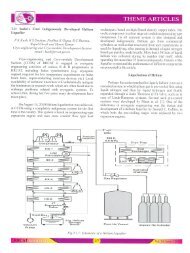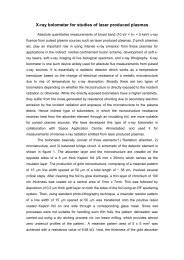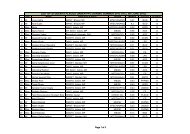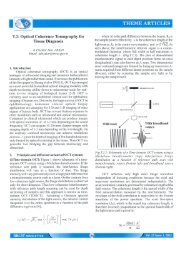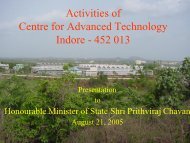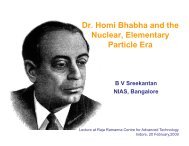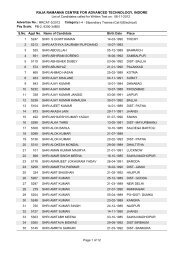Development of 30kV,22J /pulse Solid State Pulse Power Supply for ...
Development of 30kV,22J /pulse Solid State Pulse Power Supply for ...
Development of 30kV,22J /pulse Solid State Pulse Power Supply for ...
You also want an ePaper? Increase the reach of your titles
YUMPU automatically turns print PDFs into web optimized ePapers that Google loves.
LASER PROGRAMME<br />
The laser output <strong>pulse</strong> is shown in fig.L.6.5 is measured<br />
with pyro-electric detector. The measured output energy was<br />
150mJfpuise at 100 Hz. Fig.L.6.6 shows the first prototype <strong>of</strong><br />
this power supply.<br />
Reported by:<br />
D. V. Ghodke (dvghodke@rrcat.gov.in) K. Mural<br />
Krishnan N. Varshanay and N.S Benelji<br />
L.7: <strong>Development</strong> <strong>of</strong> 300J <strong>pulse</strong> energy long <strong>pulse</strong> Nd:<br />
YAG Laser<br />
The diode-pumped Nd:YAG and fiber lasers are not<br />
easy to operate in high energy, long <strong>pulse</strong> mode due to<br />
switching requirement <strong>of</strong> pump diodes. There<strong>for</strong>e, flash-lamp<br />
pumped <strong>pulse</strong>d Nd: YAG lasers with long <strong>pulse</strong> duration in the<br />
millisecond range are still important <strong>for</strong> various material<br />
processing applications. For deep penetration welding<br />
applications, it is desirable to have high energy and long<br />
duration <strong>pulse</strong>s. However, beam quality from high power<br />
Nd: YAG lasers is limited by strong thermal lensing and stress<br />
induced birefringence. Further, power scaling from single<br />
Nd: YAG rod is limited due to pump input and available rod<br />
length defined by thermal fracture limit <strong>of</strong> the rod, which is ~<br />
200 Wfcm. Thus, power scaling can be achieved by using<br />
multi-rod resonator or master oscillator power amplifier<br />
configuration (MOPA). Although, it is easy to design MOPA<br />
configuration, but due to variation in thermal focal length <strong>of</strong><br />
amplifier stage with variation in input pump power, it is<br />
difficult to achieve fiber optic beam delivery <strong>for</strong> the entire<br />
range <strong>of</strong> pump power. Thus, <strong>for</strong> fiber optic beam delivery, it is<br />
a better choice to use multi-rod resonator. It has already been<br />
reported that two-rod resonator with plane-parallel<br />
configuration has a wide stable range, when the two rods are<br />
symmetrically positioned inside the resonator. We have<br />
carried out design and development <strong>of</strong> a <strong>pulse</strong>d Nd: YAG laser<br />
providing 300 J <strong>of</strong> <strong>pulse</strong> energy with 40 ms <strong>pulse</strong>-duration<br />
using dual-rod resonator configuration.<br />
There are two identical pump chambers within the laser<br />
resonator. Each pump chamber is having a Nd:YAG rod, a<br />
lamp, and two halves <strong>of</strong> gold plated elliptical reflector. Each<br />
pump chamber contains 1.1 at.% Nd-doped rod <strong>of</strong> 10 mm<br />
diameter and 150 mm length. In each <strong>of</strong> the pump chambers, a<br />
10% samarium oxide doped glass plate is inserted between the<br />
lamp and rod to absorb the UV radiation from the lamp and<br />
convert the UV radiation into the useful visible light, thereby<br />
contributing to the laser output power. Both the pump<br />
chambers were cooled by closed-loop de-ionized water<br />
chillers. Two high voltage power supplies with master-slave<br />
configuration and rectangular current <strong>pulse</strong> pr<strong>of</strong>ile <strong>of</strong> variable<br />
duration from 2 ms to 40 ms along with capability <strong>of</strong> pumping<br />
both the cavities synchronously has been used. Figure L.7.1<br />
shows the schematic <strong>of</strong> symmetric dual cavity resonator and<br />
Fig. L.7.2 shows a view <strong>of</strong> the in-house developed. 300 J <strong>pulse</strong><br />
energy Nd:YAG laser with fiber optic beam delivery. Dual<br />
cavity resonator is constructed using a plane-plane<br />
20<br />
50%MIRR~<br />
Rod2 ~ d ~<br />
LENS<br />
Fig. L. 7.1: A schematic <strong>of</strong> the symmetric dual cavity<br />
resonator.<br />
Fig. L. 7.2 : A view <strong>of</strong> the in-house developed 300 J <strong>pulse</strong><br />
energy Nd: fA Glaser withfiber optic beam delivelY.<br />
--~'-:--~-"'-'T~-"'~'<br />
f(~ ,"I I I """<br />
I .. ~<br />
,I. ,<br />
--- I ;----- I I I....-<br />
~~_~ L U ...• • _L~ __ ~~._<br />
• (a) iiiliiii111 (b) iiiiiI<br />
FigL 7.3 : (a) Flashlamp pump-<strong>pulse</strong>, and (b) laser output<br />
<strong>pulse</strong> <strong>of</strong>300 J, 40 msfiber-coupled <strong>pulse</strong>d Nd: fA Glaser.<br />
symmetrical configuration with d: 2d: d configuration, where<br />
d is the distance between mirror and the principal plane <strong>of</strong>the<br />
rod.<br />
Figure L.7.3 shows the pump <strong>pulse</strong> and laser output<br />
<strong>pulse</strong> <strong>for</strong> 300 J <strong>pulse</strong>d Nd:YAG laser with fiber optic beam<br />
delivery. With dual rod resonator, a maximum average output<br />
power <strong>of</strong> 500 W was achieved with maximum <strong>pulse</strong> energy <strong>of</strong><br />
300 J at 40 ms <strong>pulse</strong>-duration. Maximum peak power <strong>of</strong> this<br />
laser is 10 kW. Laser <strong>pulse</strong> duration can be varied from 2-40<br />
ms with variation in <strong>pulse</strong> frequency from 1-100 Hz. Output<br />
<strong>pulse</strong> energy varies linearly with increase in input pump<br />
energy. Electrical to laser conversion efficiency is about 5%<br />
with beam quality <strong>of</strong> better than 20 mm.mrad <strong>for</strong> the whole<br />
range <strong>of</strong> operation from 0-10 kW. Laser beam has been<br />
delivered efficiently through an optical fiber <strong>of</strong> 400 /lm core<br />
diameter and 0,22 numerical aperture with 90% transmission<br />
at the fiber exit end. There are two fiber ports, which can be<br />
used on time sharing basis <strong>for</strong> different applications. Laser<br />
cutting up to a depth <strong>of</strong> ~ 20 mm and welding in SS up to a<br />
~ RRCAT~~'mm. _17 Vol. 24. Issue 1-2011



